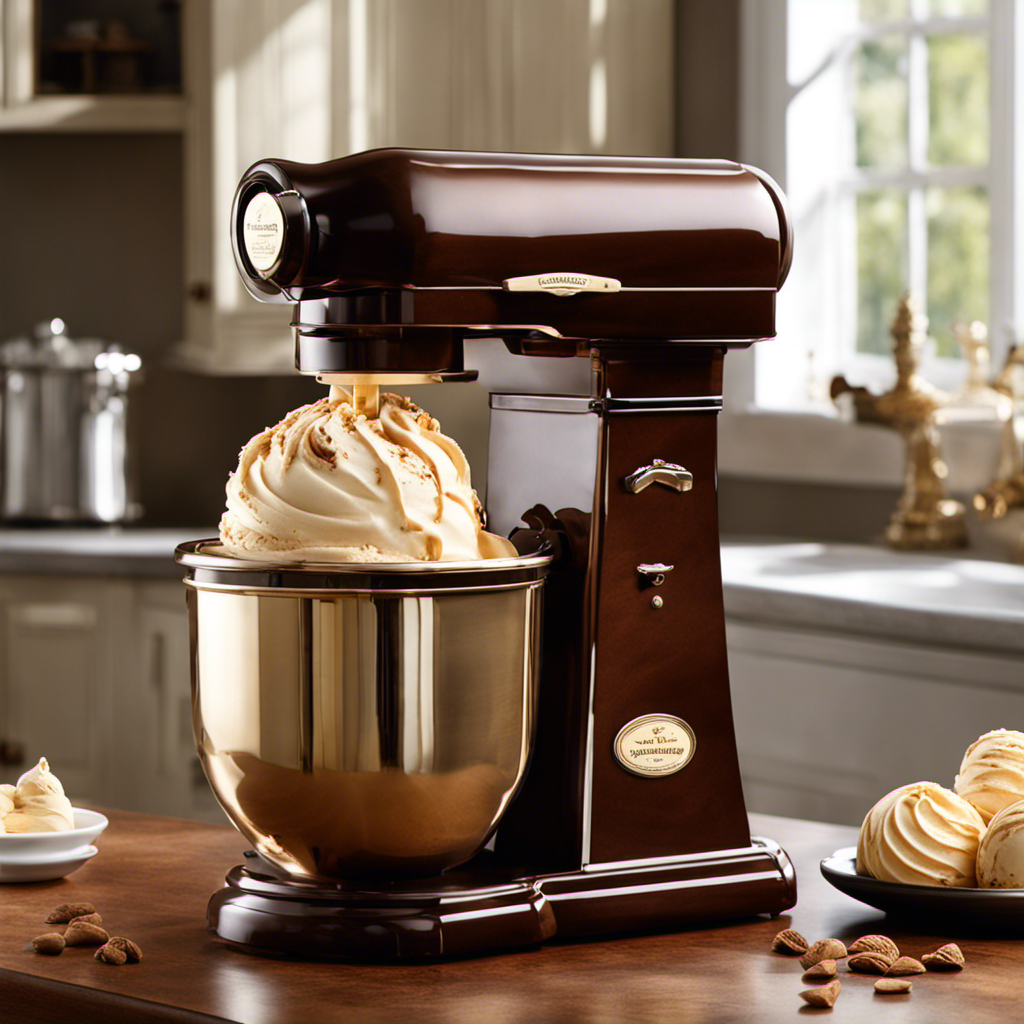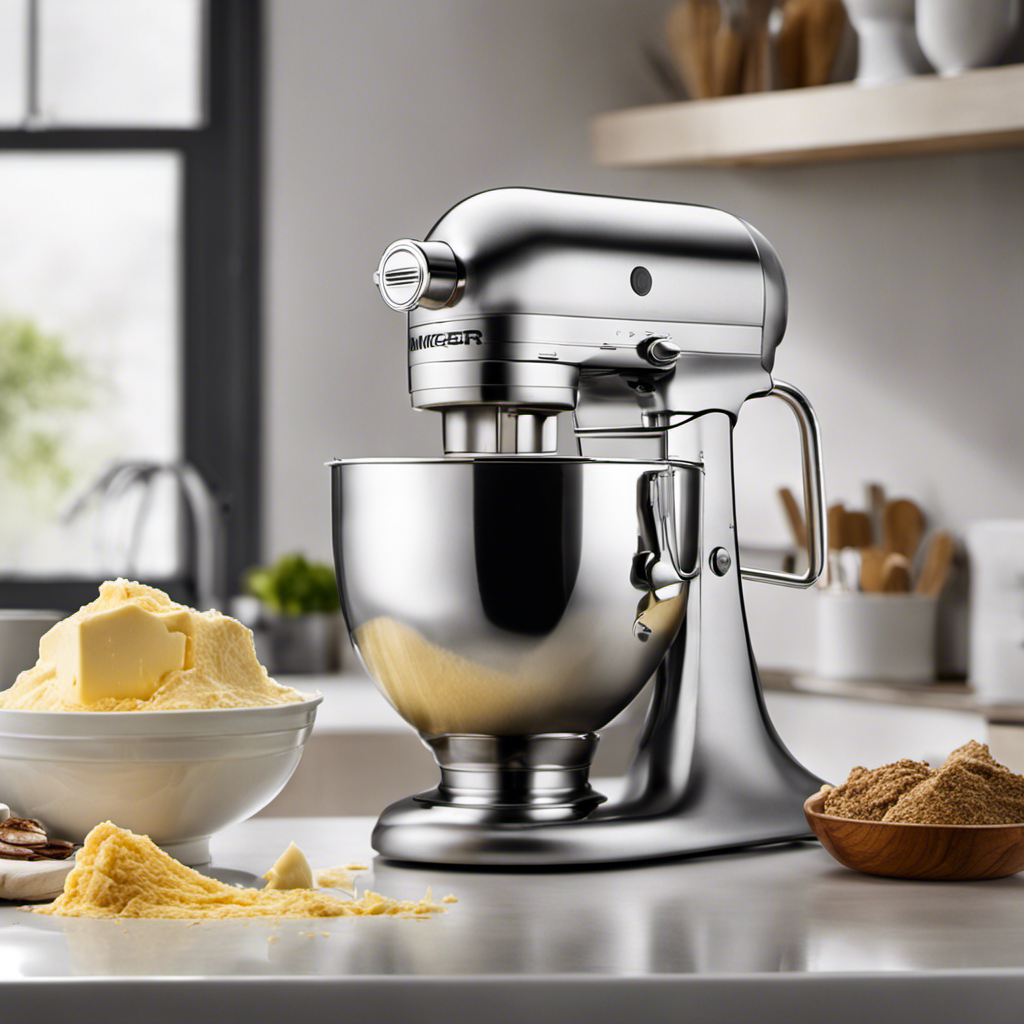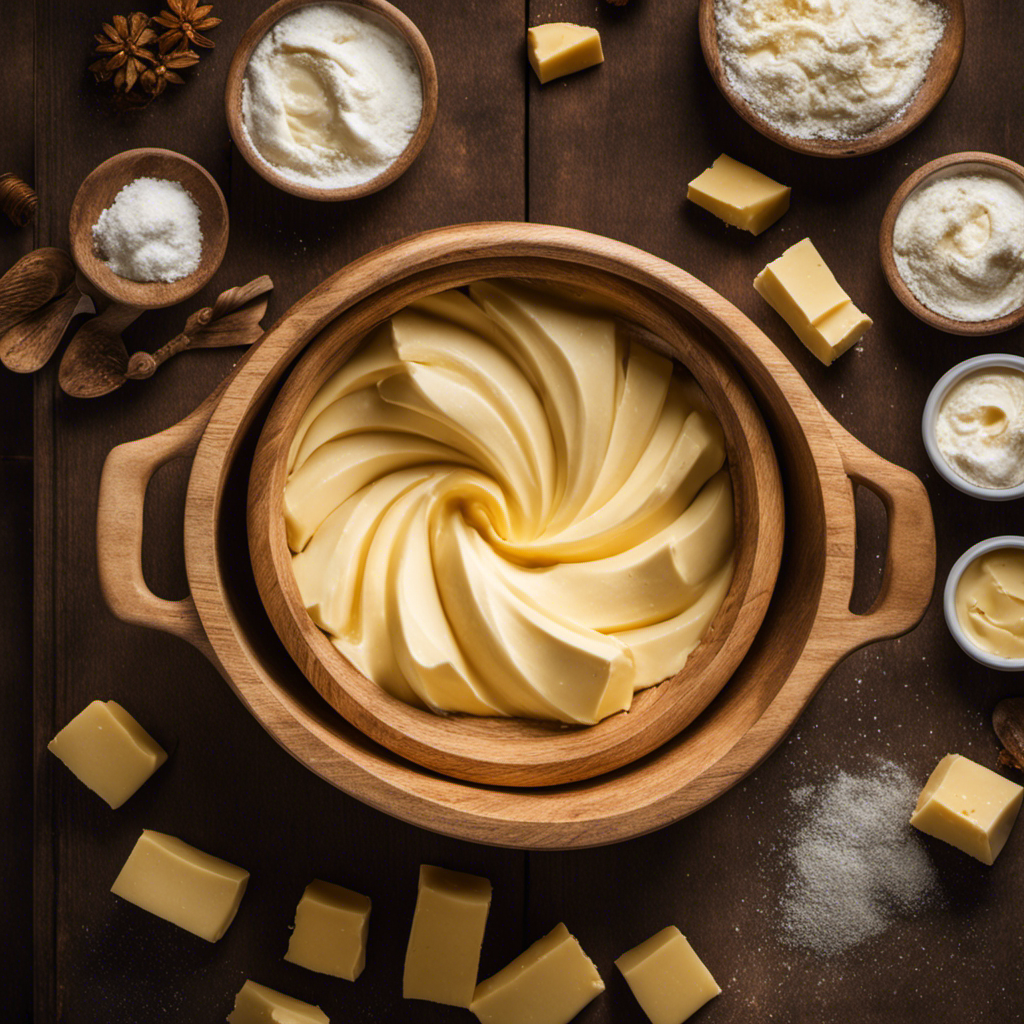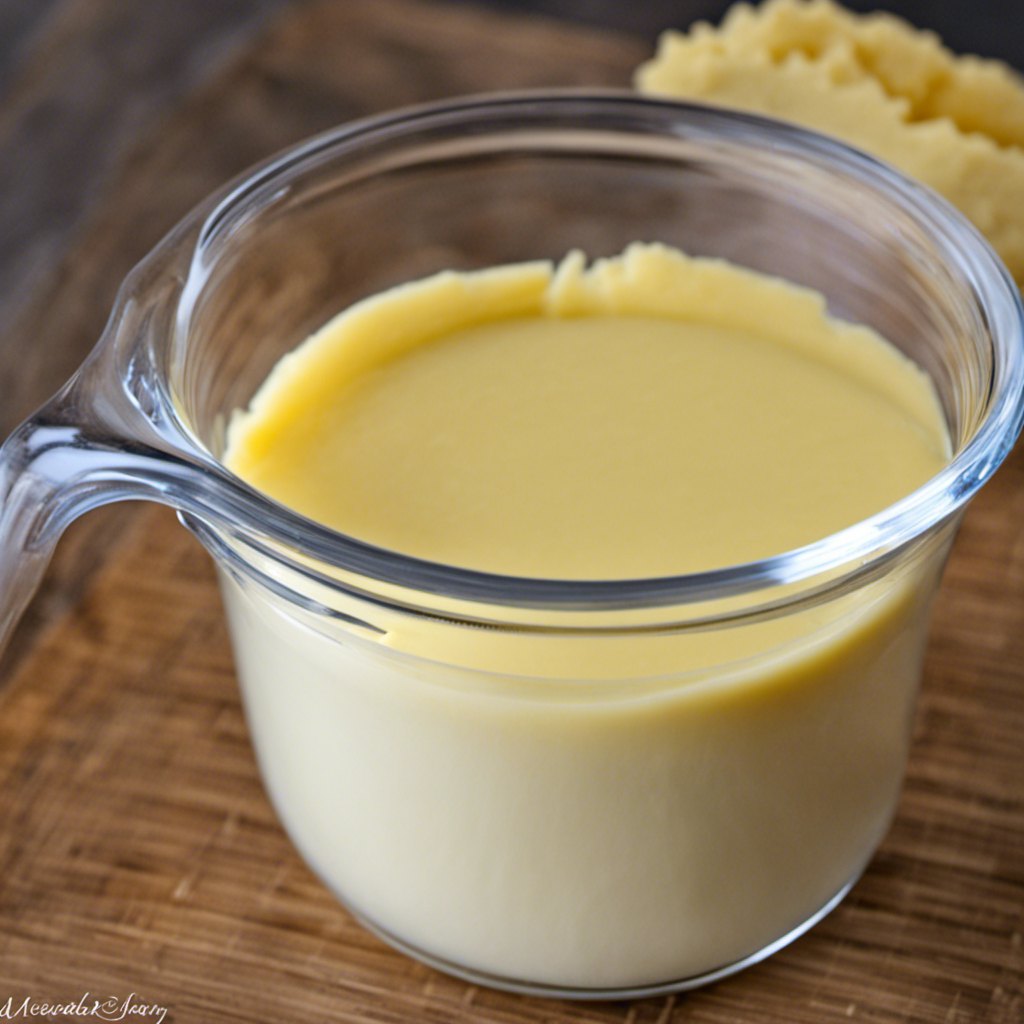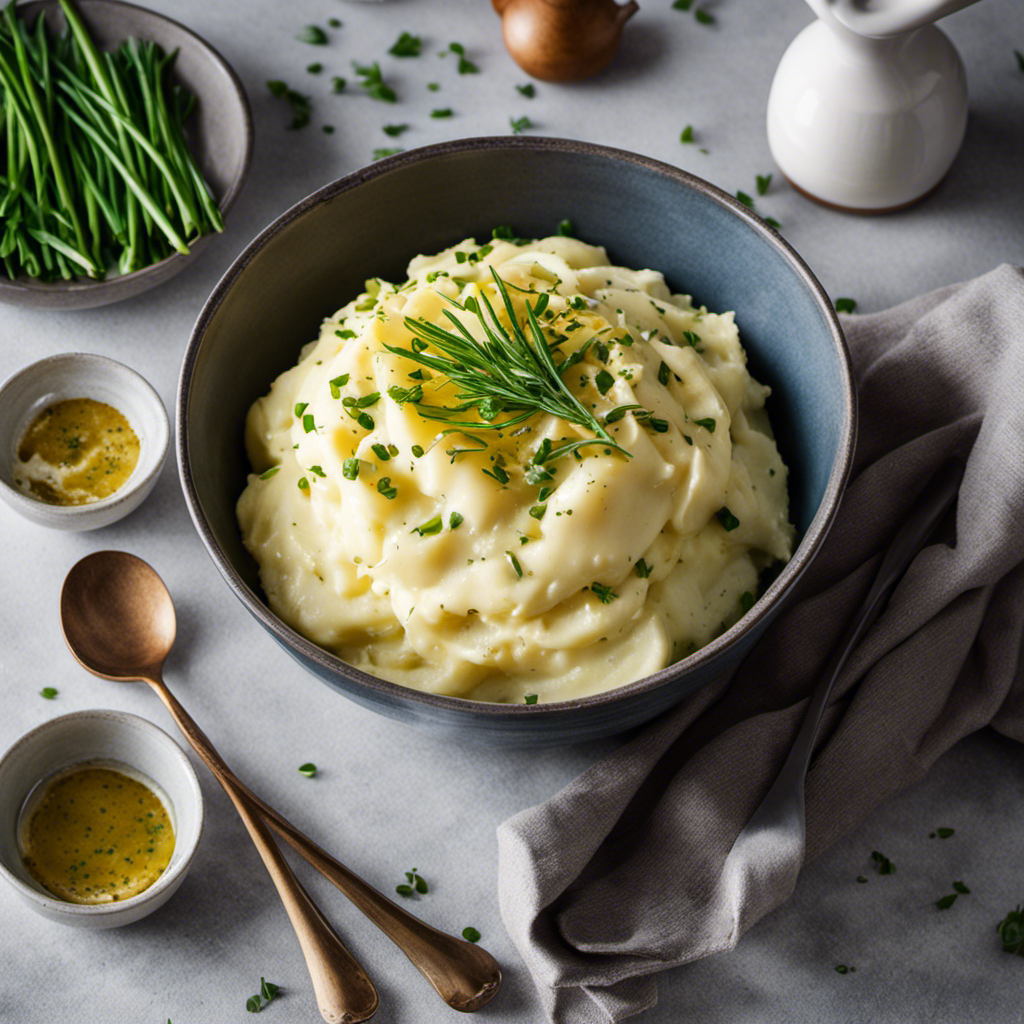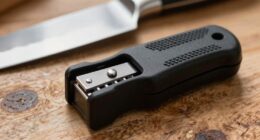I have always enjoyed treating myself to a rich and decadent dessert, particularly when it includes the irresistible duo of peanut butter and ice cream.
If you’re like me and appreciate the nostalgia of an old fashioned ice cream maker, then get ready to learn how to create the perfect peanut butter swirl.
In this article, I’ll guide you through the step-by-step process of churning, swirling, and freezing your homemade creation, so you can savor every delightful bite.
Let’s dive in and satisfy our sweet tooth together!
Key Takeaways
- Choosing the right ice cream base (vanilla or chocolate) is important to balance flavors and create the desired taste.
- Preparing the peanut butter swirl mixture involves heating it until smooth and pourable, then cooling it slightly before adding to the ice cream maker.
- Churning the ice cream base at a slow or fast speed will result in different textures (creamy or fluffy).
- Troubleshooting common issues during churning includes checking the temperature of the mixture, ensuring proper assembly of the ice cream maker, increasing churning time, and adjusting the fat content and cooling elements.
Choosing the Right Ice Cream Base
You’ll want to make sure you choose the right ice cream base for a perfect peanut butter swirl in your old fashioned ice cream maker.
When it comes to choosing the right ingredients, it’s important to consider the flavors you want to balance. A traditional vanilla ice cream base works well as a blank canvas for the peanut butter swirl to shine. Its creamy and neutral taste allows the peanut butter flavor to come through without overpowering the entire dessert.
If you prefer a richer and more indulgent ice cream, a chocolate base can be a great choice. The combination of chocolate and peanut butter creates a decadent and irresistible treat.
Preparing the Peanut Butter Swirl Mixture
Once the ingredients are mixed together, it’s important to slowly pour the peanut butter swirl mixture into the ice cream maker. Here’s a step-by-step guide on preparing the perfect peanut butter swirl for your homemade ice cream:
-
Choose your favorite peanut butter swirl recipe or try a different alternative such as almond butter or cookie butter for a unique twist.
-
In a microwave-safe bowl, heat the peanut butter swirl mixture until it becomes smooth and pourable.
-
Allow the mixture to cool slightly before pouring it into the ice cream maker. This will prevent the swirl from melting too quickly and blending into the ice cream.
-
Using a spoon or spatula, gently drizzle the peanut butter swirl mixture into the churning ice cream base. Aim for even distribution throughout the mixture.
By following these steps, you’ll achieve a delectable and visually appealing peanut butter swirl in your homemade ice cream.
Now, let’s move on to the next step – churning the ice cream base in the old fashioned ice cream maker.
Churning the Ice Cream Base in the Old Fashioned Ice Cream Maker
After pouring the cooled mixture into the churning ice cream base, it’s time to start the old fashioned ice cream maker. I carefully place the metal canister into the wooden bucket, making sure it fits snugly. Next, I attach the motor to the top of the canister, ensuring it’s securely fastened. Once everything is set up, I turn on the machine and let it start churning. The churning process is crucial for creating a smooth and creamy texture in the ice cream. It incorporates air into the mixture, preventing ice crystals from forming and giving the ice cream a light and fluffy consistency. To help you understand the importance of churning, here’s a table outlining the different ice cream churning techniques and their effects:
| Technique | Effect |
|---|---|
| Slow churning | Creamier texture |
| Fast churning | Lighter and fluffier texture |
| Intermittent churning | Enhanced flavor infusion |
Troubleshooting common issues during churning:
- Ice cream not freezing: Check if the ice cream mixture is cold enough before churning. If not, chill it further in the refrigerator.
- Ice cream not thickening: Make sure the ice cream maker is properly assembled and the canister is securely in place. If necessary, add more ice and salt to the bucket for better cooling.
- Ice cream too icy: Increase the churning time to incorporate more air and break down ice crystals. Also, make sure to use a higher fat content in the base mixture.
Adding the Peanut Butter Swirl
When it comes to creating the perfect peanut butter swirl in your ice cream, there are a few key points to keep in mind.
First and foremost, the technique you use to create the swirl can greatly impact the final result. I’ll be sharing some tips and tricks to help you achieve a beautiful and evenly distributed swirl throughout your ice cream.
Additionally, the quality of the peanut butter you choose can make a big difference in taste and texture. I’ll be discussing the best types of peanut butter to use for the perfect swirl.
Lastly, the amount of time you mix the peanut butter into the ice cream base can also affect the final outcome. I’ll be giving recommendations on the optimal mixing time to achieve the desired swirl effect.
Swirl Technique Tips
To achieve a perfect peanut butter swirl, you’ll need to carefully layer the peanut butter into the ice cream mixture as it churns. Here are some tips to master the swirl technique and create delightful flavor combinations:
-
Consistency is key: Ensure that your peanut butter is soft and easily spreadable to achieve a smooth swirl throughout the ice cream.
-
Layering technique: Start by pouring a layer of ice cream mixture into the container. Then, dollop spoonfuls of peanut butter on top. Repeat this process, alternating between layers of ice cream and peanut butter until you’ve used all the ingredients.
-
Swirling motion: Use a knife or spatula to gently swirl the peanut butter into the ice cream mixture. Avoid overmixing to maintain distinct swirls.
-
Troubleshooting: If the swirls are not distinct enough, try swirling more vigorously. If the peanut butter sinks to the bottom, freeze the ice cream for a few hours before swirling to prevent it from sinking.
Get creative with your swirl flavor combinations! Experiment with chocolate fudge, caramel, or even fruit preserves to add a burst of flavor to your homemade ice cream.
Best Peanut Butter
Your taste buds will thank you when you choose a high-quality, creamy peanut butter for your homemade swirl ice cream.
When it comes to peanut butter brands, there are a few that stand out for their smooth texture and rich flavor. One popular choice is Jif, which has a creamy consistency that blends effortlessly into your ice cream base.
Another option is Skippy, known for its slightly sweet taste and velvety texture.
For a more natural option, try Adams, which is made with just peanuts and a touch of salt.
When incorporating peanut butter into your ice cream recipes, be sure to soften it slightly before swirling it into the base. This will ensure a smooth and evenly distributed swirl throughout your frozen treat.
Mixing Time Recommendations
For optimal results, mix the ingredients until they are well combined and smooth. Here are some recommendations for mixing times to achieve the perfect peanut butter swirl in your old fashioned ice cream maker:
-
Start by mixing the ice cream base for 15 minutes. This will ensure that the mixture is well blended and all the ingredients are fully incorporated.
-
After the initial mixing, add in the peanut butter swirl. Gently fold it into the ice cream base using a spatula or a wooden spoon. Be careful not to overmix, as you want to create ribbons of peanut butter throughout the ice cream.
-
Continue mixing for an additional 5 minutes. This will help distribute the peanut butter evenly and create a smooth texture.
-
Once the desired consistency is reached, transfer the mixture to a container and freeze for at least 4 hours to allow the ice cream to set.
Troubleshooting common mixing issues:
-
If the peanut butter is not spreading evenly, try warming it slightly before adding it to the ice cream base.
-
If the ice cream is too soft or runny, mix for an additional 5 minutes and then freeze for a longer period of time.
-
If the ice cream becomes too hard, let it sit at room temperature for a few minutes before serving to soften it slightly.
Incorporating the Swirl Into the Ice Cream
Mix the peanut butter swirl into the ice cream base until well combined. To achieve the perfect peanut butter swirl consistency, it is crucial to incorporate swirl techniques effectively. This ensures that every bite of the ice cream is filled with delightful swirls of peanut butter goodness. To help you visualize the process, here is a table illustrating the steps involved in incorporating the swirl into the ice cream:
| Step | Technique | Description |
|---|---|---|
| 1 | Ribbon Swirl | Pour the peanut butter in a thin, continuous stream while slowly stirring the ice cream base. |
| 2 | Layering | Alternate layers of peanut butter and ice cream, then gently swirl with a spoon or spatula. |
| 3 | Marbling | Use a knife or skewer to create swirls by gently dragging it through the ice cream and peanut butter. |
Freezing and Firming up the Ice Cream
Now that we have incorporated the swirl into the ice cream, it’s time to focus on freezing and firming up the mixture. This step is crucial in achieving the perfect texture for your homemade peanut butter swirl ice cream.
To ensure that your ice cream turns out smooth and creamy, follow these freezing techniques:
-
Chill the ice cream mixture in the refrigerator for at least 4 hours before freezing. This allows the flavors to meld together and creates a smoother texture.
-
Set up your old fashioned ice cream maker according to the manufacturer’s instructions. Make sure the freezing canister is properly chilled.
-
Pour the chilled mixture into the canister and attach the dasher.
-
Begin churning the ice cream, following the recommended time in the instruction manual. This will freeze the mixture and create a velvety texture.
Serving and Enjoying Your Peanut Butter Swirl Ice Cream
To fully savor the delightful flavors of your homemade treat, scoop a generous portion of the peanut butter-swirled ice cream into a bowl and relish each creamy bite.
The peanut butter swirl adds a rich and nutty taste to the velvety smoothness of the ice cream.
For an extra indulgence, drizzle some warm chocolate sauce over the top or sprinkle crushed peanuts for a crunchy texture.
Another serving suggestion is to sandwich the peanut butter swirl ice cream between two chocolate cookies, creating a delectable ice cream sandwich.
To enhance the peanut butter flavor, you can also add a dollop of peanut butter on top or mix in some chunks of chocolate for a delightful twist.
No matter how you choose to enjoy it, the peanut butter swirl ice cream is sure to satisfy your sweet tooth.
Storing and Preserving the Ice Cream
When storing your homemade peanut butter swirl ice cream, make sure to seal the container tightly to prevent freezer burn. Proper storage is essential to maintain the flavor and texture of your delicious creation.
Here are some storage tips and preserving techniques to help you keep your ice cream in perfect condition:
-
Use an airtight container: Choose a container that seals tightly to prevent air from entering and causing freezer burn.
-
Place it in the coldest part of the freezer: Store your ice cream at the back of the freezer where temperatures are the most consistent.
-
Avoid temperature fluctuations: Keep your freezer at a constant temperature to prevent melting and refreezing, which can affect the quality of the ice cream.
-
Use freezer-safe materials: Opt for containers made specifically for freezing, such as plastic or glass, to ensure the best preservation.
Tips and Variations for Your Peanut Butter Swirl Creation
For optimal results, make sure you have all the necessary ingredients and equipment ready before you begin creating your peanut butter swirl ice cream.
In addition to traditional peanut butter, there are several peanut butter alternatives available that can add a unique twist to your creation. Almond butter, cashew butter, or even sunflower seed butter can be used to create a different flavor profile while still maintaining that creamy, nutty goodness.
When it comes to mix-ins, get creative! Crushed cookies, chopped nuts, or swirls of caramel can add texture and depth to your ice cream. Experiment with different combinations to find your favorite.
Remember to freeze your ice cream maker bowl ahead of time, and be patient while churning. The end result will be a deliciously creamy and satisfying peanut butter swirl ice cream. Enjoy!
Conclusion
In conclusion, making a peanut butter swirl in an old-fashioned ice cream maker is a delightful and rewarding experience.
By choosing the right ice cream base and preparing the peanut butter swirl mixture, you can create a creamy and flavorful treat.
Churning the ice cream base in the old-fashioned ice cream maker helps achieve the perfect texture.
Adding the peanut butter swirl and incorporating it into the ice cream creates a beautiful and delicious pattern.
Finally, freezing and firming up the ice cream ensures it is ready to be served and enjoyed.
With these tips and variations, you can create a truly irresistible peanut butter swirl creation.
